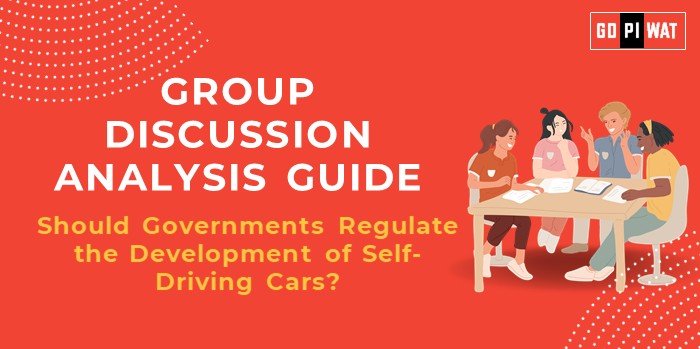📋 Group Discussion (GD) Analysis Guide: Should Governments Regulate the Development of Self-Driving Cars?
🌐 Introduction to Self-Driving Cars
- Opening Context: The advent of self-driving cars, powered by AI and machine learning, represents a monumental shift in transportation. With global investments in autonomous vehicles (AVs) exceeding $100 billion by 2023, the debate around government regulation has gained prominence as safety, ethics, and innovation intersect.
- Topic Background: Self-driving cars aim to revolutionize mobility by reducing human error, increasing road safety, and enhancing accessibility. However, their development raises questions about ethical decision-making, legal accountability, and public trust. Governments worldwide are grappling with how to balance innovation with oversight.
📊 Quick Facts and Key Statistics
- 🚗 Autonomous Vehicles Market Size (2023): $60 billion, projected to grow at a CAGR of 40% by 2030.
- ⚠️ Accident Reduction Potential: 94% of road accidents caused by human error could be mitigated.
- 📜 Regulation Status: 29 U.S. states have implemented AV-specific legislation; EU nations favor standardized rules.
- 🤔 Public Trust Levels: Only 30% of global respondents feel comfortable sharing roads with AVs.
👥 Stakeholders and Their Roles
- 🏛️ Governments: Establish legal frameworks, ensure public safety, and foster innovation.
- 💻 Tech Companies: Develop and test AV technologies while ensuring compliance with standards.
- 💼 Insurance Providers: Adapt liability models to address new risks.
- 🚶 Citizens: Key beneficiaries and critics influencing policy through public opinion.
🏆 Achievements and Challenges
✨ Achievements
- Reduced accidents and fatalities in pilot programs (e.g., Waymo’s driverless fleet in Arizona).
- Enhanced mobility for disabled individuals and the elderly.
- Environmental benefits through optimized driving and fuel efficiency.
⚠️ Challenges
- Ethical dilemmas in AI decision-making (e.g., prioritizing passenger vs. pedestrian safety).
- Legal uncertainties regarding accidents and liabilities.
- High development and infrastructure costs.
🌍 Global Comparisons
- 🇺🇸 Success in the U.S.: Regulatory sandbox initiatives in California.
- 🇩🇪 Challenges in Germany: Balancing innovation with stringent EU safety norms.
📚 Structured Arguments for Discussion
- 💪 Supporting Stance: “Government regulation ensures safety, fosters public trust, and creates a fair playing field for all innovators.”
- ❌ Opposing Stance: “Overregulation can stifle innovation and delay the societal benefits of autonomous technology.”
- ⚖️ Balanced Perspective: “Regulation is essential but must be adaptive, encouraging innovation while prioritizing safety and ethical practices.”
💡 Effective Discussion Approaches
- 📊 Opening Approaches:
- “The global autonomous vehicle market’s rapid growth demands proactive regulatory measures to address safety and ethics.”
- “Self-driving cars promise significant societal benefits, but their unchecked development could lead to unforeseen risks.”
- 🎯 Counter-Argument Handling:
- “While innovation thrives in less regulated environments, lack of oversight could erode public trust and delay adoption.”
- “Cost concerns are valid, but history shows that early investments in safety frameworks yield long-term savings.”
🔍 Strategic Analysis of Strengths and Weaknesses
- ✅ Strengths: Reduced accidents, environmental benefits, enhanced accessibility.
- ❌ Weaknesses: High R&D costs, ethical decision-making dilemmas, legal uncertainties.
- 🚀 Opportunities: Public-private partnerships, global leadership in AV innovation.
- ⚠️ Threats: Public distrust, cybersecurity vulnerabilities, uneven regulatory environments.
🎓 Connecting with B-School Applications
- 📌 Real-World Applications: Use cases in operations (logistics optimization), finance (investment analysis), and ethics (policy creation).
- ❓ Sample Interview Questions:
- “How can governments balance innovation and safety in self-driving car regulations?”
- “What role should private companies play in shaping AV policies?”
- 📘 Insights for Students:
- Ethical considerations in AI-driven decisions.
- Policy frameworks for emerging technologies.
- Economic implications of AV adoption.


